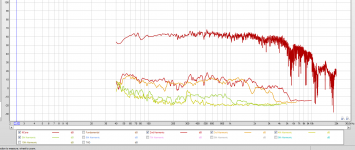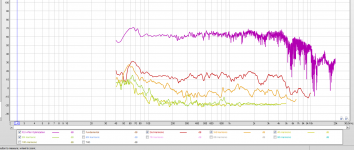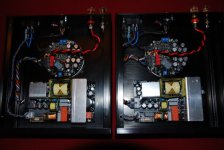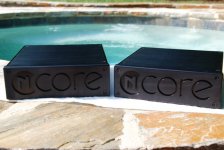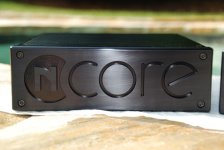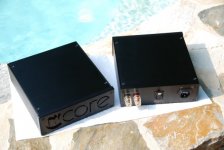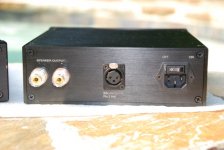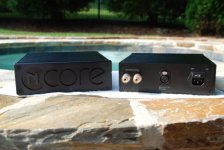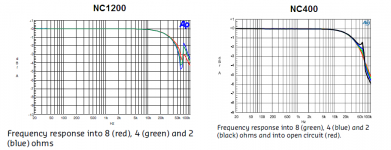Hello all again... I now have a more technical review of the NCore vs the Firstwatt F2J on one of my speaker drivers. The driver is currently mounted in a ported box and is specced at 90 db efficiency. The db level I have no exact number on, but was not super-quiet and not ear shatteringly loud, so don't take the exact numbers as absolute truths 
First up the NCore:
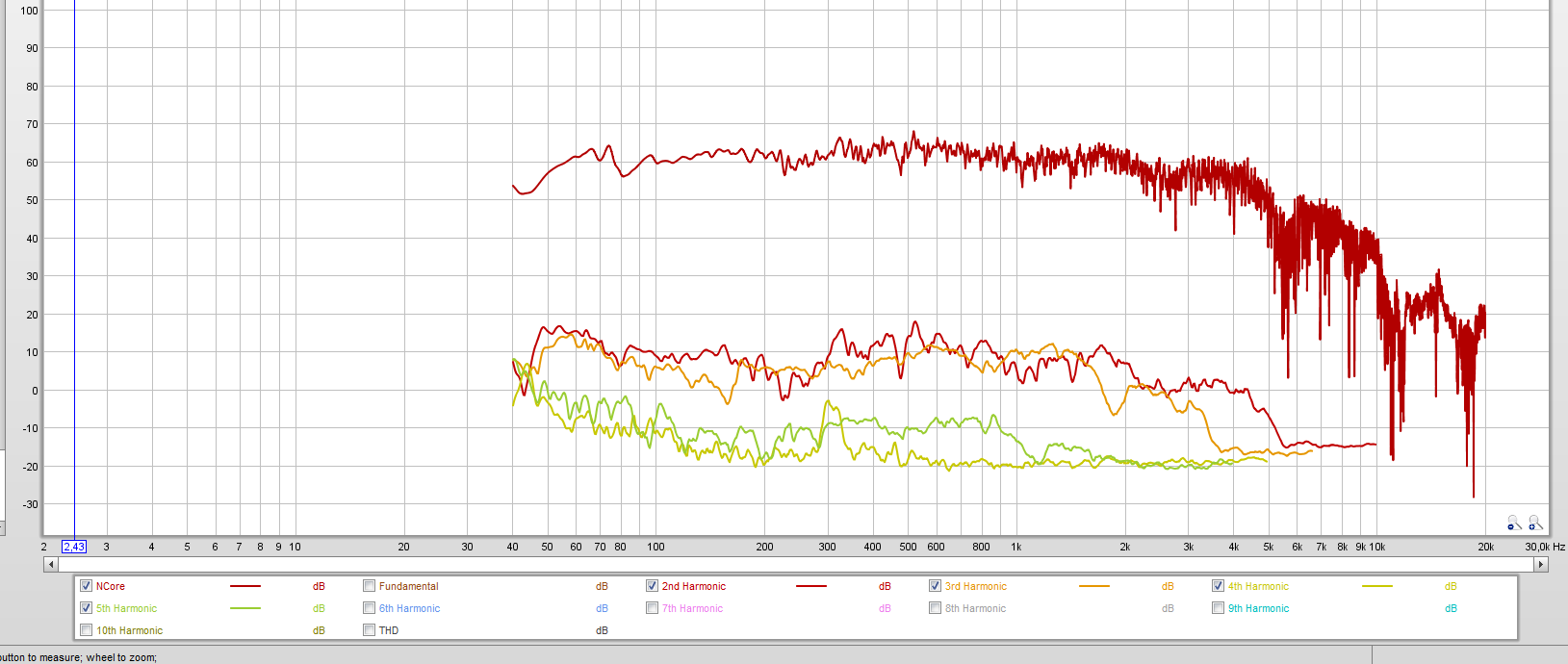
Next up the F2J EDIT: In my F2J I skipped the parallell resistors so output impedance should be about 700.

Keep in mind that the F2J is a current source, and the response difference might mostly be due to that. But whatever the reason the measurements for me speak for themselves, I will in my future speaker probably use my NCores for the bass and midbass and then use F2Js for mids and upwards.
So Bruno... I know you said Hypex wouldn't produce a current source NCore but what about after you have delivered the DLCP... pretty please?
First up the NCore:
Next up the F2J EDIT: In my F2J I skipped the parallell resistors so output impedance should be about 700.
Keep in mind that the F2J is a current source, and the response difference might mostly be due to that. But whatever the reason the measurements for me speak for themselves, I will in my future speaker probably use my NCores for the bass and midbass and then use F2Js for mids and upwards.
So Bruno... I know you said Hypex wouldn't produce a current source NCore but what about after you have delivered the DLCP... pretty please?
Attachments
Last edited:
Here are some NCores that I built.
Oooh! Sexy!
Follow-up to Post #4554 (Past post of temp data w/ cover off, also see this for measurement parameters)
Method:
Amp at idle for 6 hrs with vented cover installed. Cut power. Remove cord. Remove chassis cover. Check power supply rails @< 24 VDC. Press TC bead against surface with finger using a 0.5 mm thick coated fiberglass cloth until temp reading stabilizes. Record non-corrected data. All data taken within 3 minutes of cover removal.
Note:
The coated fine weave fiberglass cloth reduces errors due to the heat sink effect of the finger, as well as protects it from electrical shock and heat burns!
These data are less accurate than the previous data, because I did not wait as long as previously for temp stabilization. This is a trade-off between errors due to surface cooling and errors due to thermocouple time constant.
All temp measurements were done with the power turned off and the power cord removed. Power supply rails below 24VDC.
Room air: 21.6 C
UCD 400 ( most surfaces too hot to touch > 1 sec)
Output inductor: 54 C
Main electro-cap: 51 C
Blue T-Bar: NM
User heatsink: 53 C
Non HS TO-220 devices: 85 C
NC 400 ( most surfaces too hot to touch > 1 sec)
Output inductor: 55 C
Highest temp of 10 electro caps: 61 C
User heat sink: 42 C
SMPS 600 ( most surfaces too hot to touch > 1 sec)
Main xfmer: NM
Small HS: 49 C
Large HS original: NM
Large HS w/ user CPU style HS added: 50 C
My Conclusions:
This is a stunning amount of power capability in a very small and light weight package! Well done!
Surface temperatures appear normal for reliable modern gear to me, although I prefer about 10 C more thermal margin for even more extended reliability.
The user added CPU HS (e.g. designed for horizontal use) on the SMPS600 large HS brings it's temp down to about the temp of the SMPS600 small HS.
If the SMPS600 large HS raises in temp approximately the same as the small HS with the cover installed, then the original large HS would theoretically measure about,
46.5*(49/36) ~= 63 C
The 85 C measurement on the UCD TO220's bothers me, but hey, my various UCD amplifiers have survived 6 summers just fine...
Regards, DavidT
Method:
Amp at idle for 6 hrs with vented cover installed. Cut power. Remove cord. Remove chassis cover. Check power supply rails @< 24 VDC. Press TC bead against surface with finger using a 0.5 mm thick coated fiberglass cloth until temp reading stabilizes. Record non-corrected data. All data taken within 3 minutes of cover removal.
Note:
The coated fine weave fiberglass cloth reduces errors due to the heat sink effect of the finger, as well as protects it from electrical shock and heat burns!
These data are less accurate than the previous data, because I did not wait as long as previously for temp stabilization. This is a trade-off between errors due to surface cooling and errors due to thermocouple time constant.
All temp measurements were done with the power turned off and the power cord removed. Power supply rails below 24VDC.
Room air: 21.6 C
UCD 400 ( most surfaces too hot to touch > 1 sec)
Output inductor: 54 C
Main electro-cap: 51 C
Blue T-Bar: NM
User heatsink: 53 C
Non HS TO-220 devices: 85 C
NC 400 ( most surfaces too hot to touch > 1 sec)
Output inductor: 55 C
Highest temp of 10 electro caps: 61 C
User heat sink: 42 C
SMPS 600 ( most surfaces too hot to touch > 1 sec)
Main xfmer: NM
Small HS: 49 C
Large HS original: NM
Large HS w/ user CPU style HS added: 50 C
My Conclusions:
This is a stunning amount of power capability in a very small and light weight package! Well done!
Surface temperatures appear normal for reliable modern gear to me, although I prefer about 10 C more thermal margin for even more extended reliability.
The user added CPU HS (e.g. designed for horizontal use) on the SMPS600 large HS brings it's temp down to about the temp of the SMPS600 small HS.
If the SMPS600 large HS raises in temp approximately the same as the small HS with the cover installed, then the original large HS would theoretically measure about,
46.5*(49/36) ~= 63 C
The 85 C measurement on the UCD TO220's bothers me, but hey, my various UCD amplifiers have survived 6 summers just fine...
Regards, DavidT
is that my vectorial logo?Here are some NCores that I built.
I would've gone for a smaller one but it's not for me to enjoy it
Here are some NCores that I built.
Beautiful casework, JT.
Will correct and report back.
Best Regards
Sven
Report?? Still have noises?
Alan
Hello all again... I now have a more technical review of the NCore vs the Firstwatt F2J on one of my speaker drivers. The driver is currently mounted in a ported box and is specced at 90 db efficiency. The db level I have no exact number on, but was not super-quiet and not ear shatteringly loud, so don't take the exact numbers as absolute truths
First up the NCore:

Next up the F2J EDIT: In my F2J I skipped the parallell resistors so output impedance should be about 700.

Keep in mind that the F2J is a current source, and the response difference might mostly be due to that. But whatever the reason the measurements for me speak for themselves, I will in my future speaker probably use my NCores for the bass and midbass and then use F2Js for mids and upwards.
So Bruno... I know you said Hypex wouldn't produce a current source NCore but what about after you have delivered the DLCP... pretty please?
Interesting measurements, thanks!
And with the current source you seem to also get a slight boost in the high, probably following a rise of impedance of your driver. The same things goes around 60Hz (probably the resonant frequency of your driver in your box).
And 15dB of 3rd order distortion reduction!
This back ups my own measurements pretty well.
Have you tried the same test with a resistor on the output of the ncore (something like 2x your driver impedance should be enough to get most of the effect distortion/response-wise).
Even with such (or higher) a resistor you would get more power from the ncore than from the 5W of the F2J.
Last edited:
Interesting measurements, thanks!
And with the current source you seem to also get a slight boost in the high, probably following a rise of impedance of your driver. The same things goes around 60Hz (probably the resonant frequency of your driver in your box).
And 15dB of 3rd order distortion reduction!
This back ups my own measurements pretty well.
Have you tried the same test with a resistor on the output of the ncore (something like 2x your driver impedance should be enough to get most of the effect distortion/response-wise).
Even with such (or higher) a resistor you would get more power from the ncore than from the 5W of the F2J.
Yeah, before I tried to convert the NCore into a current sorce long back in this thread I also tried to put a resistor, I used 30 ohms then in front of a 8 ohm speaker. I got the frequency response slightly changed as expected and a reduction in distortion but very slight, not even close to what you got earlier in the thread where you reported 10-15+ db reduction or what I got now.
I could re-make the test with resistor included also and post graphs, and then I might even be ambitious enough to make an SPL reading so the numbers are more real =)
Last edited:
Everybody and his cousin mounts TO220s without heatsinks, in spite of the 85% or so reduction in rated dissipation. So the heatsink police won't come knocking at your door... this time....The 85 C measurement on the UCD TO220's bothers me, but hey, my various UCD amplifiers have survived 6 summers just fine...
Thanks for posting these measurements. You can use a q-tip to press the probe tip against a surface.
No kidding! Got to hide those photos from the children!Beautiful casework, JT.
Last edited:
Now for the electrical tests.
The UCD400's performed with aplomb as they normally do, however the NC400's show a ringing of about 4 cycles @ 62.5 kHZ on a 10kHZ square wave with an amplitude close to the carrier amplitue of 300mv rms. It shows a resemblance the to ultrasonic transformer ringing in some (famous, shh )tube power amplifiers...
Other than the ringing, the NC's perform as expected. The ringing is not audible to me in a short test with Joshua Bell playing the Tchaikovsky. The amps present a very clean sound with mesmerizing detail...
I tried to upload photos to show this, but no joy, as this message came up:
"Your submission could not be processed because a security token was missing."
Does someone know a work-around to upload photos?
Also, is it normal for NC's to ring?
Regards,
DavidT
The UCD400's performed with aplomb as they normally do, however the NC400's show a ringing of about 4 cycles @ 62.5 kHZ on a 10kHZ square wave with an amplitude close to the carrier amplitue of 300mv rms. It shows a resemblance the to ultrasonic transformer ringing in some (famous, shh )tube power amplifiers...
Other than the ringing, the NC's perform as expected. The ringing is not audible to me in a short test with Joshua Bell playing the Tchaikovsky. The amps present a very clean sound with mesmerizing detail...
I tried to upload photos to show this, but no joy, as this message came up:
"Your submission could not be processed because a security token was missing."
Does someone know a work-around to upload photos?
Also, is it normal for NC's to ring?
Regards,
DavidT
Hello Serengetiplains,
Thanks, what a relief. I was not looking forward to going round-and-round on that issue...
That BP post was so many moons ago in December, that I forgot about that 62 kHz wrinkle...I have been enjoying this adventure in real time and started building around January... BTW, my saucer-sections are from the second build, I believe.
I can also add that the detail retrieval is trancendent to me because I do get flashback-glimmers of the feelings of my time as a youth as 1st stand viola. THAT is mesmerizing....Bravo Bruno!
Thank-you again,
DavidT
Thanks, what a relief. I was not looking forward to going round-and-round on that issue...
That BP post was so many moons ago in December, that I forgot about that 62 kHz wrinkle...I have been enjoying this adventure in real time and started building around January... BTW, my saucer-sections are from the second build, I believe.
I can also add that the detail retrieval is trancendent to me because I do get flashback-glimmers of the feelings of my time as a youth as 1st stand viola. THAT is mesmerizing....Bravo Bruno!
Thank-you again,
DavidT
Here is Bruno's quote from #1014 (to save some searching) :
DavidT, with what load did you measure the ringing?
Looking at the ~60khz glitch of the response curve in the data sheets it looks like it gets lower when the impedance rises (and it is also much lower in the NC400 compared to the NC1200).
The frequency response plot is given in the data sheet. It shows a ripple around 60kHz (corresponding to a local minimum in the loop gain, see the white paper) and for no reason other than ordinary time-frequency duality this means that the impulse response (and its integral, the step response) must have a corresponding wrinkle as well.
DavidT, with what load did you measure the ringing?
Looking at the ~60khz glitch of the response curve in the data sheets it looks like it gets lower when the impedance rises (and it is also much lower in the NC400 compared to the NC1200).
Attachments
Ncore consists of a simple self-oscillating amp (inner loop) with an outer loop wrapped around it, whereby a distortion-free linear model tries to model the closed-loop response of the inner loop as closely as possible and whose output is subtracted from the feedback before it's fed into the outer loop. This way the outer loop sees only the difference between the two (i.e. distortion). As a necessary byproduct of making a lot of extra loop gain in the audio range, the outer loop introduces introduces the loop gain minimum near 70kHz and hence potentially ringing. The closer the model matches the inner loop, the less signal the outer loop sees and hence the smaller the ringing.
As it stands the model accuracy is limited by component tolerances and on the output impedance of the inner loop. So if you were to take a family of curves on a whole lot of NC400's you'd find that the shape of the "blip" varies from unit to unit, with some not showing any at all at 4 ohms. Those units have no ringing either (at least at 4 ohms).
A more sensible way of looking at it is output impedance, since the model gets no feedback from the output. There, you won't see much variation across units. All have a maximum at sixty-something kHz. This peak corresponds to the Z of the output inductor divided by one plus loop gain. It's a cosmetic disadvantage of Ncore vs UcD, which has a famously tight squarewave response. It just goes to show that squarewave response only says so much about sound quality, which is not much
As it stands the model accuracy is limited by component tolerances and on the output impedance of the inner loop. So if you were to take a family of curves on a whole lot of NC400's you'd find that the shape of the "blip" varies from unit to unit, with some not showing any at all at 4 ohms. Those units have no ringing either (at least at 4 ohms).
A more sensible way of looking at it is output impedance, since the model gets no feedback from the output. There, you won't see much variation across units. All have a maximum at sixty-something kHz. This peak corresponds to the Z of the output inductor divided by one plus loop gain. It's a cosmetic disadvantage of Ncore vs UcD, which has a famously tight squarewave response. It just goes to show that squarewave response only says so much about sound quality, which is not much
Hi,
Being as I don't seem to get many answers emailing the HQ, can anyone please let me know what sort of wait time they have experienced after sending back their amps for adjustment? I am well into month number two at this point, having been assured they would ship last Monday, after much prodding. I am so glad I spend the $ to get them to Ncore quickly...
Being as I don't seem to get many answers emailing the HQ, can anyone please let me know what sort of wait time they have experienced after sending back their amps for adjustment? I am well into month number two at this point, having been assured they would ship last Monday, after much prodding. I am so glad I spend the $ to get them to Ncore quickly...
Hi,
Being as I don't seem to get many answers emailing the HQ, can anyone please let me know what sort of wait time they have experienced after sending back their amps for adjustment? I am well into month number two at this point, having been assured they would ship last Monday, after much prodding. I am so glad I spend the $ to get them to Ncore quickly...
What kind of adjustment? I didn't know that Hypex had a Chriopractor on site.
DC Offset?
Hi,
Being as I don't seem to get many answers emailing the HQ, can anyone please let me know what sort of wait time they have experienced after sending back their amps for adjustment? I am well into month number two at this point, having been assured they would ship last Monday, after much prodding. I am so glad I spend the $ to get them to Ncore quickly...
Please send me all info (info at hypex dot nl), some guys are on holiday now...
Sam Lord: "You can use a q-tip to press the probe tip against a surface."
Nice idea, thanks!
pos: "DavidT, with what load did you measure the ringing?"
8.1 ohm (via Fluke 179), 10.9 uH (via Extech LCR 380193), 50W resistor, both channels driven into two resistors at various levels up to clipping.
8 ohm is the average measured impedence of my SS 18W/8531-g00 mid-woofer centered around 330 Hz, which appears to be the rough center of power in most symphony music. Of course, it does dip to around 5 ohms around 200 Hz...
Regards,
DavidT
Nice idea, thanks!
pos: "DavidT, with what load did you measure the ringing?"
8.1 ohm (via Fluke 179), 10.9 uH (via Extech LCR 380193), 50W resistor, both channels driven into two resistors at various levels up to clipping.
8 ohm is the average measured impedence of my SS 18W/8531-g00 mid-woofer centered around 330 Hz, which appears to be the rough center of power in most symphony music. Of course, it does dip to around 5 ohms around 200 Hz...
Regards,
DavidT
- Status
- Not open for further replies.
- Home
- Amplifiers
- Class D
- Hypex Ncore
